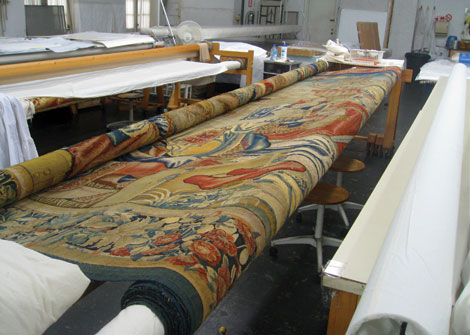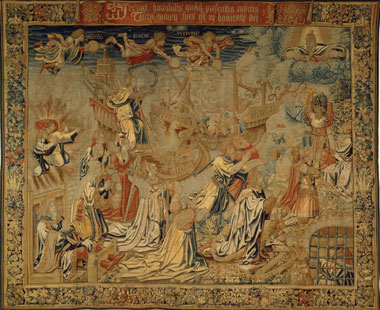 Spring 2009
Spring 2009|
“ A museum of our caliber needs to demonstrate what its strengths are. In some cases, less is more.” - Jason T. Busch, Carnegie Museum of Art’s Alan G. and Jane A. Lehman curator of Decorative Arts
|
Year of Restoration
 The Triumph of Hope, a Flemish tapestry from the 1530s, is being restored at a renowned textile conservation lab in New York City. Photo: Michael Belman
From a lab in New York City to a new storage and study area in Pittsburgh, Carnegie Museum of Art makes ready for the return of decorative arts.
After nearly five centuries, dust, ash, and soot have degraded its wool and silk threads. Gravity, too, has punished the 200-pound hanging textile by opening up small gaps in its fabric. But for this majestic tapestry, many of time’s insults will soon be diminished. Triumph of Hope, a 14- by 18-foot Flemish tapestry that dates to the 1530s, is among the many treasures undergoing a rebirth as part of Carnegie Museum of Art’s “Year of Decorative Arts.” But that rebirth is occurring far from home, in the renowned Textile Conservation Laboratory at the Cathedral Church of St. John the Divine in New York City. Michael Belman, Carnegie Museum of Art’s objects conservator who is overseeing the $48,000 restoration project, says the museum chose the lab because it was one of the few in the country that could handle a tapestry as sprawling as Triumph of Hope.
Currently, they’re restoring weak areas, splits, and missing fibers by hand, with needle and color-matched thread (leaving intact other meticulously made repairs, some dating as far back as 400 years), before shipping it back to Pittsburgh for display as part of a special exhibition, Gods, Love, and War: Tapestries at Carnegie Museum of Art. Scheduled to open in December in the Heinz Galleries, the tapestry show will be a fitting complement to the November reopening of the museum’s Ailsa Mellon Bruce Galleries, an historic decorative arts initiative two years in the making. Jason T. Busch, Carnegie Museum of Art’s Alan G. and Jane A. Lehman Curator of Decorative Arts, has spent much of the past two years combing through the museum’s collection of nearly 7,000 decorative objects, including textiles, furniture, ceramics, glass, and metalwork. Under Busch’s direction, the museum created a new storage and study area for the department, with museum-standard shelving and an area for curators and visiting scholars to study the collection. Busch and his colleagues use the study area to examine the museum’s extensive collection of European and American decorative arts and to mock-up installations that will come to fruition in the Bruce Galleries. Decorative arts, also called applied or industrial arts, encompasses a wide array of crafted objects, from chairs and tapestries to bowls and jewelry. “This museum has a real strength in decorative arts from the mid-18th century through the present, which naturally mirrors the growth of Pittsburgh and this region,” Busch says. The gallery’s namesake was a prominent collector whose gift to the museum instantly established Carnegie Museum of Art as home to a leading collection of early European decorative art, particularly 18th-century French furniture and German and English ceramics. But the galleries looked dated prior to their closing in 2001 as part of the long-range renovation plans for both the Scaife and Bruce galleries, and the museum hired Busch in 2006 to reimagine how it would display its decorative arts collection. “They’re tough decisions,” says Busch, of deciding which pieces to put on permanent display. “A museum of our caliber needs to demonstrate what its strengths are. In some cases, less is more.” The final selection includes nearly 500 objects representing a wide span of designs and eras. The objects will include French porcelain, 18th-century mahogany furniture, Louis Comfort Tiffany stained glass, and contemporary furniture made of fiberglass and polyurethane. Also on display will be the restored gilded and rosewood faux-grained parlor furniture from PicNic (c. 1835), the country home of William Croghan and his daughter, Mary Schenley. The furniture will be conserved and put on permanent view for the first time, in a display evoking its original setting. “In bringing it all together, what we’ve done is give viewers an opportunity to look forward and back, to see how the past has influenced the present,” Busch explains. “We make a strong case for the evolution of style and design using decorative arts from the mid-1700s to today.” Just a month after the Bruce Galleries reopen, Gods, Love, and War will draw attention to the museum’s collection of tapestries, including Triumph of Hope. Busch and intern Richard L. Simmons, who is organizing the exhibition, selected a small group of tapestries, many of which were crafted during Europe’s medieval and Renaissance periods. Some of them portray biblical and mythical scenes and were once hung inside drafty castles, abbeys, and mansions. During public events such as religious ceremonies, they were often hung outside. It will be a bountiful year for decorative arts, and Busch expects the exhibitions to be memorable for museumgoers. “I think there’s an access with decorative arts that really resonates with the public,” he says. “Everyone owns objects of glass and wood. Everyone has a chair.” |
Carnegie Museums After Dark · Art Without Walls · Recollecting Andrey Avinoff · Look… to see, to remember, to enjoy · President's Note · NewsWorthy · Now Showing · Face Time: Kim Amey · About Town: Art in Bloom · Science & Nature: Scientists Among Us · Artistic License: Bosom Buddies · Another Look: 13 Most Beautiful… · Then & Now: Earth Day
 |
Copyright © 2017 CARNEGIE Magazine. All rights reserved. |

 Under the direction of Marlene Edelheit, the head of conservation at St. John, conservators were able to gently wash the tapestry thanks to the lab’s custom 16- by 20-foot washbasin with a rolling catwalk above it. One of the most important steps in the restoration, the washing removes dust, soot, and even tobacco stains. Many of these particles are acidic and break down the threads holding the textile together. “Pollutants and other harmful materials adsorb on these tapestry fibers,” says Belman. “If you don’t reduce them, they'll continue to degrade the silk and wool fibers over time.”
Under the direction of Marlene Edelheit, the head of conservation at St. John, conservators were able to gently wash the tapestry thanks to the lab’s custom 16- by 20-foot washbasin with a rolling catwalk above it. One of the most important steps in the restoration, the washing removes dust, soot, and even tobacco stains. Many of these particles are acidic and break down the threads holding the textile together. “Pollutants and other harmful materials adsorb on these tapestry fibers,” says Belman. “If you don’t reduce them, they'll continue to degrade the silk and wool fibers over time.”